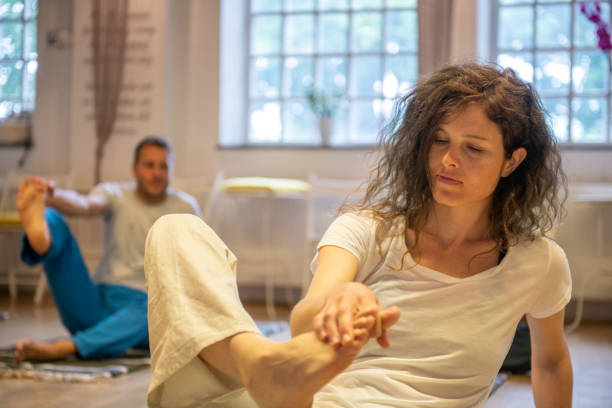There are many ways to help alleviate your foot pain, but what if you want to do it without medication — without conventional pain relief? Using the Feldenkrais Method to relieve foot pain offers the perfect solution for those who want to heal their pain naturally.
Introduction
The Feldenkrais® Method is a body-mind integration approach that uses specific movements and directed attention to alter how the nervous system works, improving the body’s range of motion and muscle tension. It has been used for decades to influence and subsequently improve various medical conditions and can be used to change foot pain.
What is the Feldenkrais® Method?
The Feldenkrais® Method is not a technique but rather an educational and learning approach that uses movement to improve function and reduce pain. Dr. Moshe Feldenkrais developed the method based on the knowledge that the nervous system oversees and maintains a state of balance across all systems in the body, known as self-regulation or homeostasis. Dr. Feldenkrais also knew that even though we cannot control the nervous system, we could strongly influence the neurocircuitry of the system. This influence was potent in cultivating our body’s recovery, resiliency, and ability to adapt positively across our life span, freeing us to move unrestrictedly once again.
The somatic learning approach changes painful and restricted conditions, including foot pain. One study found that people who received this approach had improved function and reduced pain compared to those who received standard care.
If you are experiencing foot pain, you may consider using movement and sensation-based explorations, as it can be very beneficial for your condition.
How to Use the Feldenkrais Method to Relieve Foot Pain
The feet are essential since they are the body’s support base—distributing and carrying all your body weight as you stand, walk, climb, dance, and run. Without healthy feet, we lack the stability for walking and healthy balance—responsive ankles, knees, and hip joints. The feet, knees, and hips are crucial to ensure optimal positioning of the pelvis, which houses the location of our center of mass. Located near the base of the spine, or sacrum, the center of mass is the balance point around which body parts (inside and out) move. The nervous system closely and constantly monitors the relationship between this point and the support base to ensure that we stay safely upright and avoid hitting our heads.
The core or cause of foot pain results from a prolonged and adverse relationship between the base of support and the center of mass. It doesn’t matter if the pain is aching, burning, throbbing, numbness, or tingling. It doesn’t matter if it is labeled or diagnosed as plantar fasciitis, a pinched nerve in the lumbar and sacral spinal levels, or in the forefoot, commonly called a neuroma. Bunions, hammertoes, deformed-crossed toes, or sesamoiditis are other diagnoses that reflect symptoms but not the root cause.
For example, if you put more weight on one side of the foot or your toes, you form calluses across the skin in areas that receive the most pressure. That is your body’s first line of defense when it detects too much friction, wear, or strain across the skin. We usually dismiss or ‘pumice-away’ these toughened, callous spots. A better option would be to consider these areas as clues actively reflecting how we chronically carry excessive weight loads into these areas because of the habitual and non-useful alignment between one’s base of support and center of mass.
There are consequences of placing uneven weight distribution across your feet. Pain that begins as a nuisance always escalates to a bigger problem. 20 or 30 years go by, and you eventually change your gait or how you walk. The unnoticed relationship between gravity, the base of support, and the center of mass becomes insidious and maladaptive. It can strongly influence whether we regain our balance should we start to fall, not to mention it can cause chronic knee, hip, or spinal pain and even the need for joint replacement surgery.
Foot pain consciously and actively reflects how we chronically carry excessive weight loads into areas that eventually lead to wear, compression, and local tissue damage. These loads result from movement patterns created either as an adaptation to an injury, fall, accident, or disease.
When we pay attention to our body’s signals, we can learn how to interpret and redirect our movement patterns before a significant problem occurs. When we know how to use a Feldenkrais® somatic approach, it is easy to influence how we stand, walk, dance, or run because we are privy to automatically what the nervous system tries to do.
The Feldenkrais Method invites you to experience and understand movement patterns that allow your center of mass to stack up and over your support base. It makes each step easier, distributing your body weight more evenly across the length and width of the foot while loading your spine, pelvis, and hips more effectively.
As a somatic practitioner, I encourage you to join me for our upcoming class so we can ease your fear of pain and increase your ability to understand the real message behind a minor limp or nuisance.
Looking for a gentle way to reduce foot pain without medication or surgery? The Feldenkrais® Method may be a good option. To determine the right movement therapy for your condition, reach out to me today for a consultation.
At Montgomery Somatics, we specialize in somatic education. Thomas Hanna, a Feldenkrais student, is widely credited with coining the term “somatic,” which derives from the Greek word sō-mă, which means “body.” The Feldenkrais® Method, Alexander Technique, Rolfing, Hanna Somatics, and other forms of somatic education became popular in the early to mid-1900s. Visit our website to learn more.

